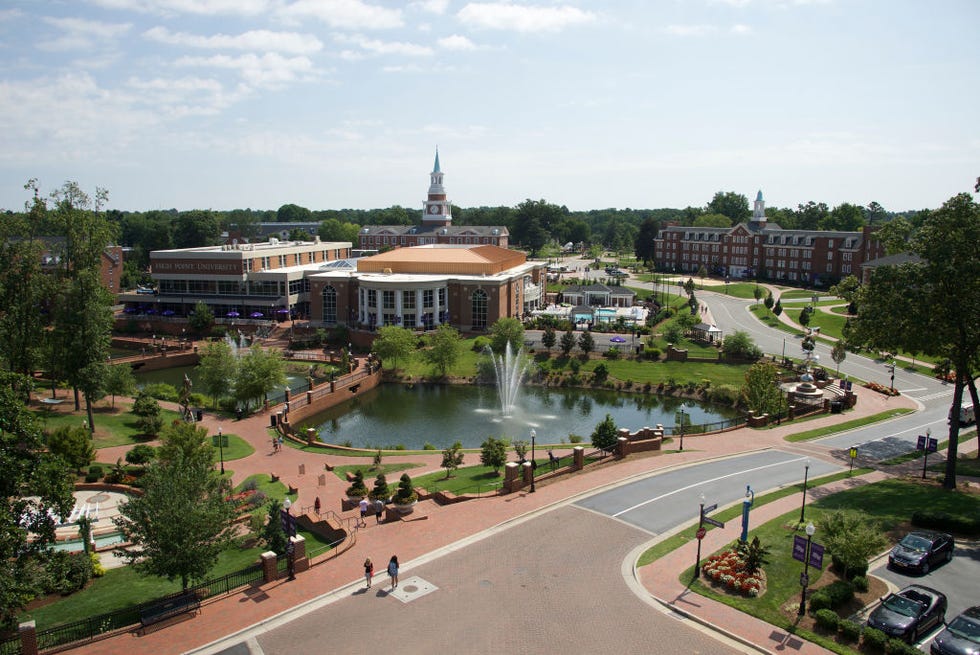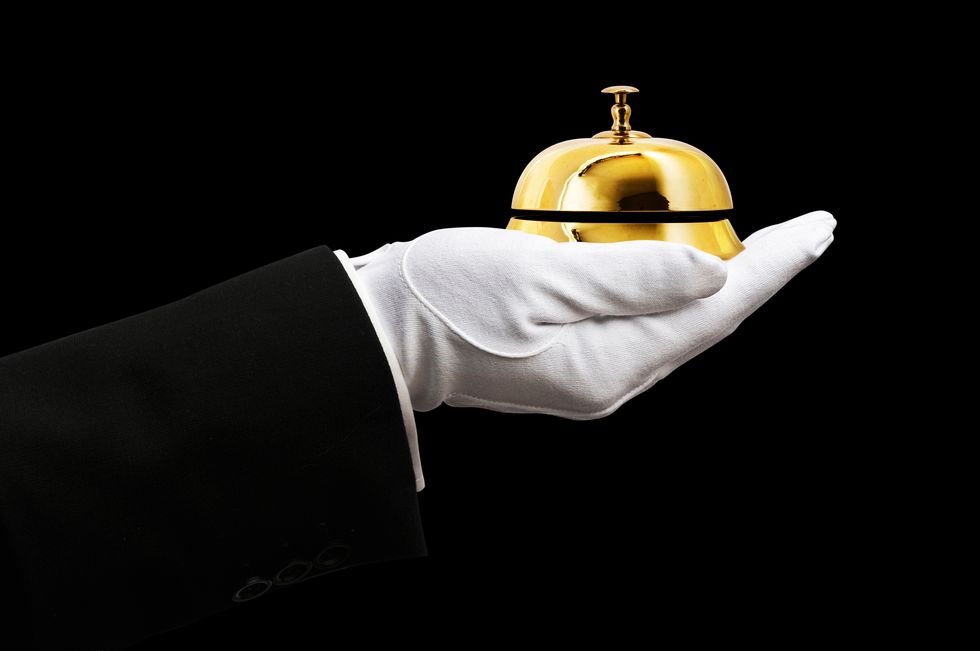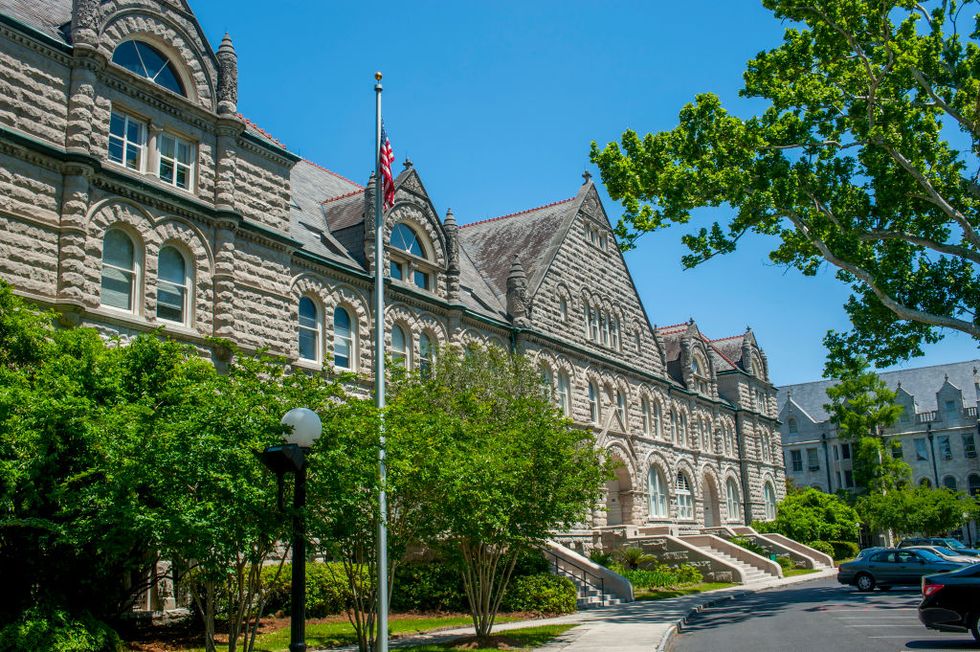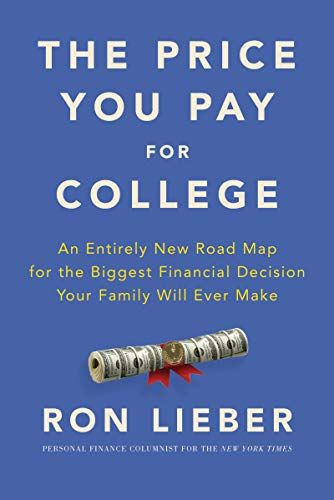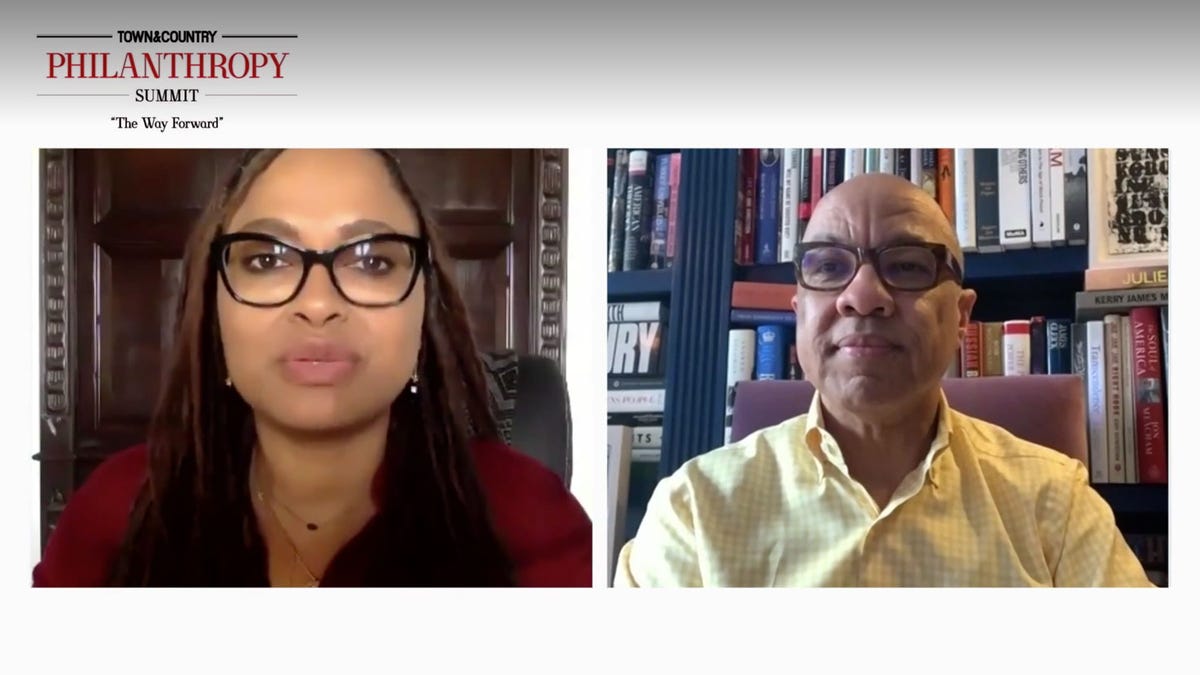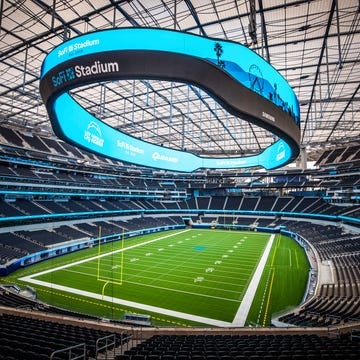In a normal year, college visits have their own distinctive choreography, from the awkward wait prior to the group information session to the backward walk of the trivia-spouting tour guide.
Then there is High Point University, in High Point, North Carolina, which does an altogether different dance. You do not show up on campus so much as arrive. The security guard at the double archway main entrance has been expecting you and checks you off a list. Each parking spot has its own LED sign, and yours has your child’s name and hometown.
Out behind the admissions office check-in desk is a swimming pool, the first of five in the open air. Next, the tour, during which uniformed students drive you around in oversize covered golf carts that save you from sweating in the sun. You will visit the on-campus steakhouse. The student union has a concierge.
Much of this is pretty new—so new that plenty of people in America have never even heard of High Point, which has tripled its population of undergraduates, to 4,500, in just 16 years. But among a certain subset of moneyed families, it’s now a regular stop on college tours. To rubberneckers who delight in observing how undergraduate institutions sell themselves, High Point has been a years-long source of fascination.
$300K
Cost of four years of tuition, room, and board at many private colleges.
The past year has been anything but normal, and yet, despite pandemic-related closures at other schools and protest marches throughout the land, High Point—and other small colleges like it—has more or less continued on its merry way.
There wasn’t much debate about whether to come back quickly. By late April last year, about six weeks after shutting down due to the pandemic, it had already announced its intention to reopen in August. More students than ever turned up for the fall semester. “We would call it a packed house,” Nido Qubein, High Point’s president, told a local business publication.
Count me among the rubberneckers. Over several years I roamed the country sampling college tours and chatting up families while working on a book about what to pay for college and why. And it’s true, the eye can’t help wandering to physical campus infrastructure that is shiny and new. In Ohio and Minnesota, talk on the tours was of which dorms were getting air conditioning or free laundry machines that text you when your clothes are dry. Many dining halls have maps highlighting local farms that supply the food.
Until March, all of this merely felt a bit much, an occasion to raise an eyebrow and talk about kids these days. By summer, however, it began to look like the keen strategy it was all along. Most colleges and universities didn’t have the financial resources to weather another shutdown. That’s why so many reopened, or tried to—not because they were certain it was safe.
As a business plan, it worked. In part because students wanted to get out of their childhood bedrooms and back to all of this, and also because the residential undergraduate rite of passage is so baked into our culture that many parents cannot bear not to bestow it upon their children. But there may be another factor at play: a consumer group used to getting what it wants even in the age of so many restrictions. For them, does the college with the plushest pitch win?
Sticker Shock
Every school in radical replace-and-refurbish mode raises a question familiar to anyone who has been on either side of a transaction involving a wristwatch, or a perfume, or a night or 10 at the Four Seasons: How far should any given school go when pulling the levers of luxury, and which among the families is most likely to notice?
The rack rate at many flagship state universities is now over $100,000 for four years of tuition plus room and board, and dozens of private colleges have unapologetically passed $300,000. At these prices, it is reasonable for families to expect more.
But more of what, exactly? Even more than with jewelry or luxury cars, this purchase is an emotional one. It is, after all, our children we’re talking about. Amid a global pandemic, it is natural to wonder whether some new order may emerge that won’t require so much damn money.
2.5%
Nationwide amount that undergraduate enrollment shrank during 2020–21 pandemic (much less than experts predicted).
I wouldn’t count on it. Only a tiny number of colleges and universities reduced tuition for the 2020–21 school year. Nationwide, undergraduate enrollment fell by only 2.5 percent. Students want to be in school, and they and their families will pay for it, even during a pandemic. But why? First, a theory of the case, distilled from the years I’ve put in talking to families and the schools that market to them.
Most students are looking for three things. First, there’s the education—the experience of having your brain stripped bare and rebuilt. Then there’s the quest to find your people—the friends who will stand up at your wedding, and the older mentors, too. Finally, going to college is about acquiring a degree that will mean something to others. This may simply be the raw baseline credential that allows you to jump a few rungs up the social class ladder into a stable accounting or nursing career.
But for many families, degree-seeking is a quest to maintain status: having their children continue the family tradition at the alma mater, or someplace better, or someplace face-saving, at least, when it’s time for the social media sweatshirt reveal.
High Point’s genius was in its lack of delusion. The city of High Point, renowned for furniture manufacturing and marketing but not as a mecca for teenagers, founded the school in 1924 in cooperation with the Methodist Protestant Church. By the time Nido Qubein took over as president, in 2005, it had fewer than 1,500 undergraduates and no clear reason for being. There was no obvious way to make its education, opportunities for kinship, or credentials stand out. So Qubein came up with a fourth way: raising the lived experience of the average undergraduate to a level that surpasses that of nearly any other school in the country.
Amenities Arms Race
This wasn’t a new idea, exactly. The upgrade of undergraduate amenities had been going on for a while, as colleges copied tactics from other industries and began to make them their own.
The dorms came first, as an ever larger number of schools felt the need to set the undergraduates up in the manner to which they had become accustomed. The alternative was to lose them to peer schools that would.
Next was ways to fill leisure time. Climbing walls didn’t cost much to build, but they became a sort of bogeyman for old-school types who thought higher education had gone rotten. Water features cost more, but they make an outsize impression. At Louisiana State University, the lazy river spells out LSU. At the University of Missouri, tour guides let families know that its river’s grotto drew inspiration from the Playboy Mansion.
$12K
Additional annual fee (on top of the $15,438 base price) for High Point’s Tier 5 room and board plan.
High Point’s dorm room salesmanship is not quite so crass, but the way it lists its prices is revealing. The entry level room and dining plan costs $15,438, but that comes with an asterisk, letting you know that the price is for the so-called Tier 1. “There will be an additional investment for students choosing an upgraded housing option,” the fine print reads. Topping off at Tier 5 requires an additional $12,256, more than the average American invests in retirement savings each year. In the top tiers you get to live in a single on a high floor, or in a better dorm, or have your own bathroom, or perhaps all three.
If housing is sold as an “investment,” this five-figure amount doesn’t purchase you a mere bed. It is literal enrichment, at least in theory. Qubein has been unabashed about this sort of thing. “I want my children to be exposed to the finer things,” he told a Bloomberg Businessweek reporter. “Most parents do.”
That said, Qubein told me he thinks too much has been made of High Point’s luxury amenities. Without the physical transformation that took place in the first decade or so of his leadership, he does not think the university would have survived. Now he finds talk of water features boring. “If you look carefully, they are the cheapest kinds of pools,” he said. “These are not lazy rivers. You don’t see slides.”
Emptied Pools
When colleges shut down in March 2020, the more expensive ones faced tough questions, and eventually such schools as the universities of Colorado and Miami faced lawsuits. Consider our three-prong theory. First, the learning. Few schools dared argue that Zoom rooms could replicate the magic that a skilled professor can make in a room filled with live undergraduates.
Second, the kinship. Without residence halls, extracurricular activities, and post-class coffee, much of this went away too. Students missed it like crazy, and they proved it by podding up with one another to live in group homes, both near campus and far away, when many colleges went mostly remote in the fall of 2020.
That left the credential, which is all well and good but is a tough sell at $50,000 or more per year. So we should not be surprised that High Point made that early call to bring everyone back in the autumn. But what of the High Point credential? The school puts a finer point on it through its trademarked tagline: Premier Life Skills University. It’s a place that gets you ready, which is something that selective liberal arts colleges can struggle to prove.
The school boasts about how its “faculty listen to the demands of the marketplace.” All students get a personal success coach during their first year. And the school should brag, given that 97 percent of the class of 2019 was employed or continuing its education within six months of graduation. If your school doesn’t have much in the way of pedigree just yet, you push career readiness and trajectory.
Advanced Marketing
Selling High Point would be easier if the school were a bit more established, and in this respect it is not alone. Provide enough amenities and concierge-level support at a private college, and any school can become a luxury product. A luxury brand, however, is something else entirely—something that a university president can’t conjure up in just a decade. Luxury brands compete on scarcity, and in higher education this means selectivity.
Consider the schools about which you would have some degree of conviction that their names would serve your children’s résumés well. You know, the ones where you’d gladly pay full price. Do any of them accept more than half of their applicants? “If you want something to be popular with rich white people, tell rich white people they can’t have it,” said Jon Boeckenstedt, who was vice president of enrollment management and marketing at DePaul University in Chicago when he uttered those words to me. (He has since moved on to a similar role at Oregon State University.) This is something the University of Southern California has understood well as it has evolved. Unlike High Point, USC had a big enough endowment and an attractive enough location that it was able to upgrade its student body significantly.
USC benefited from good luck and favorable trends. Universities in world class cities, such as Northeastern, Tulane, and Vanderbilt, have all profited from an increasing desire among students to attend school in urban environments. Also, the growth of the Common Application—and schools using marketing schemes to attract more applicants and then reject larger numbers of them—has meant that USC has had more students to choose from.
And then there is the hidden discounting system known as merit aid, which Northeastern, Tulane, and USC have used particularly well. In this system a fraction of the best admitted students get a five-figure discount offer that has nothing to do with ability to pay. A $15,000 “scholarship” makes teenagers feel exalted and parents more accomplished. Then, hopefully, the awards pull enough kids away from Berkeley and Cornell that the student body gets smarter and U.S. News & World Report takes notice in its rankings.
And sure enough, look at the acceptance rates: Northeastern took 20 percent of its applicants. Tulane came in at 11 percent; Vanderbilt at 9 percent. None lead with poshness.
USC is a slightly different story, owing to a sort of psychological complex left over from years of being known as, among other things, University of Second Choice. In 2017, after years of acquiring land for much-needed housing, it opened its $700 million USC Village development. With a budget of that size, it could have had its pick of modernist architects, but instead it went neo-Gothic, with various faculty in residence throughout and a dining commons straight out of Hogwarts. The collection of buildings practically begs the world to take the university more seriously, and it seems to be working. The school accepted just 16 percent of the kids who applied for undergraduate admission for 2020.
Even so, the snickering was audible when the news broke in 2019 that parents were paying bribes, via a crooked counselor named Rick Singer, to try to guarantee admission there and elsewhere. Melissa Korn, who wrote a book about the scandal called Unacceptable with her Wall Street Journal reporting partner, Jennifer Levitz, remembers the emails that landed that first day.
“It was interesting to see people on the East Coast scoff, like, ‘Why would you need to bribe your way into USC?’ ” she said. “People were not aware of how selective it had gotten.”
The scandal seemed to roll right off schools like Yale and Georgetown, which were also involved. So what makes USC different from them? Old reputations die hard, and the other thing the school has spent a generation trying to live down is its University of Spoiled Children moniker. USC Village had to be nice enough to help lure brainiac teenagers and others like them away from the Ivy League, but not so lavish as to make them think the school was unserious.
In Washington, DC, it has become ever clearer which schools have to trade up in amenities and which need not care. Until it went on hiatus due to the pandemic, an Instagram account with the handle @georgetown.hotmess posted a series of gross-out photos featuring campus mold, atrocious food, and vermin of all sorts.
Nevertheless, the school accepted just 15 percent of high school applicants in 2020, just a bit above its all-time low. High Point accepted 77 percent in 2020.
The Hidden Costs
Brands that can charge whatever they please tend to wear that fact as a badge of honor. This gets more complicated in higher education, however, which is a service that the majority of parents believe their children need. More than two-thirds of individual Americans don’t even earn the $75,000 that the most expensive colleges charge each year. Without a lot of aid, any school charging that much looks exclusionary.
USC invests a decent amount of money in welcoming students who qualify for Pell Grants, meaning they come from lower-income families. Among all undergraduates, 21 percent are Pell recipients. The school also meets all of the need they demonstrate via their financial aid applications.
High Point can’t afford that. It asks students from households with incomes of $50,000 or less to pay, on average, more than twice what USC does. And its Pell Grant percentage in 2018 was 10.4 percent, down seven points in as many years.
Luxury education brands of longer standing are usually flush enough to help more lower-income students, if they choose to. But the providers of newer luxury products can’t just yet.
97%
Percentage of High Point’s class of 2019 that was either employed or continuing its education six months after graduation.
Which is not to say that High Point is the least equitable private college or university in the country when it comes to Pell representation. But it’s close. Elon University, less than an hour’s drive from High Point, will live in ignominy for the time being, at the bottom of the list at 8.8 percent Pell students. Oberlin, Wake Forest, Villanova, Kenyon, Notre Dame, and Washington & Lee help High Point bring up the rear, according to an analysis that the journalist James Murphy did for the advocacy organization Education Reform Now.
Among this group at the bottom of the list, High Point’s percentage of students receiving Pell Grants has fallen the farthest in the past seven years.
Was this deliberate? No—though Qubein was quick to answer in the affirmative when I asked him whether High Point would have gone out of business if, as its undergraduate population grew, one in five students had been Pell eligible. He also pointed out that 10.4 percent of a bigger undergraduate body means a larger number of Pell students, in absolute terms, than 17.7 percent of a much smaller one.
These numbers have not inspired much in the way of campus protest, even in a year chock-full of it all over the nation. The new student body president at High Point professed a desire, in an interview with the campus newspaper, to see the school prioritize student involvement, mental health, diversity, and transparency, but he didn’t go into much detail. Just 25 percent of High Point students identify as something other than white, and that’s the school’s highest figure ever.
How might the experience of 2020 change the way the school sells itself? I surveyed a half dozen North Carolina–based members of Accept, a group of progressive professionals who specialize in helping low-income and BIPOC students get to and through college. Fascinatingly, none of the ones who work with high school students had much to say about High Point. They didn’t know the place well, hadn’t sent kids there, and were skeptical about whether financial aid would be available for their counselees.
High Point’s ongoing growth plan does call for $700 million in scholarships, and the school says it seeks to improve diversity and increase aid for first-generation students and veterans. But it’s nearly impossible to save a school—let alone improve it by leaps and bounds—without money. And if you don’t have a big pool of extremely wealthy donors at the ready, and you can’t borrow from a bank or in the bond market without limits, then you have to find students who can pay their way to fund the transformation.
In this respect, High Point is a wild success. It is giving the teenage students and their parents what they want. That 97 percent placement rate means that few High Point graduates are failing to launch. And what is an education without some kind of a future?
Katherine Dunleavy arrived at High Point in the fall of 2014 wanting to make a career in strategic communications. Brand buffing was her course of study, and she worked as one of the campus concierges. Getting that gig is competitive, and it is no folly, either.
“You learn to be resourceful,” she said. “I don’t think it’s a stretch to say that it does more for the concierges than it does for the students.”
Dunleavy graduated on time, in 2018, with a few internships under her belt, and she quickly achieved her goal of moving to New York City with a plum job in her field. Did she get what she paid for at High Point? “I think I got more,” she said.
So perhaps in 2021, with the economy still shaky as many of us await our vaccine jabs, a solid credential plus a few creature comforts are more than enough for plenty of families. Meanwhile, you probably shouldn’t count on schools that make a habit of catering to students from high-income families to get much cheaper. Those undergraduates desperately want to get back on campus, so the demand is there. Colleges need their revenue, and they’ll fight one another to get it.
The 2021–22 school year will probably be safer, even if it isn’t perfect. Many affluent families are in better financial shape than they were a year ago. And who among us is likely to downgrade our child’s undergraduate experience in this of all moments?
Schools that are luxury brands or those that promote their luxury products think they know the answer. They see us, and many of them are betting that few of us will have the nerve to say no.
Ron Lieber's The Price You Pay for College: An Entirely New Road Map for the Biggest Financial Decision Your Family Will Ever Make was published by Harper in January.
This story appears in the March 2021 issue of Town & Country.
SUBSCRIBE NOW

